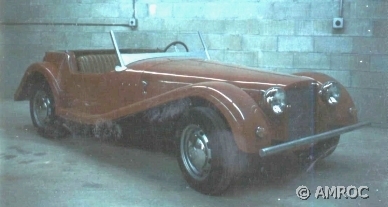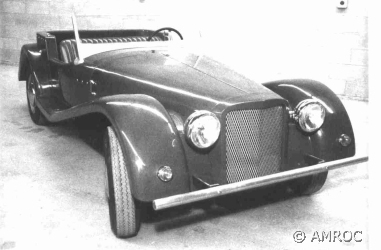The
Stalgia
In 1976 AMROC designed and built a
prototype called the Stalgia. Basically a generic design somewhere
between a Morgan and an MG. The idea was to produce a body kit based on
the VW chassis which was the simplest and most popular chassis for
building a sports car from a kit.  This
was about the time several fiberglass body kits were being produced.
They all had one fault, the production rate was slow, about one car per
week, and the bodies looked just like what they were, fiberglass copies
of metal cars. One of the primary advantages to using fiberglass was
that the body could be molded in one or a few pieces. All the seams a
metal car would normally have were smoothed over and the color often
molded into the fiberglass, much like what is done today with boats.
While the nice smooth boat with molded in color has advantages over a
wooden boat, the sports car body molded the same way was obviously a
"replica" copy of a metal body and lost much of it's "nostalgiac"
appeal. The "Stalgia" was to be a replica as close as possible to a
real metal bodied sports car.
This
was about the time several fiberglass body kits were being produced.
They all had one fault, the production rate was slow, about one car per
week, and the bodies looked just like what they were, fiberglass copies
of metal cars. One of the primary advantages to using fiberglass was
that the body could be molded in one or a few pieces. All the seams a
metal car would normally have were smoothed over and the color often
molded into the fiberglass, much like what is done today with boats.
While the nice smooth boat with molded in color has advantages over a
wooden boat, the sports car body molded the same way was obviously a
"replica" copy of a metal body and lost much of it's "nostalgiac"
appeal. The "Stalgia" was to be a replica as close as possible to a
real metal bodied sports car.
The design of the "Stalgia"
incorporated both fiberglass and ABS plastic. The concept was to use
the fiberglass for a basic "chassis" molded of fiberglass and all the
other components vacuum formed from the thermoplastic ABS. The body kit
was made from a total of fifteen seperate parts which were assembled
with welting where it normally would have been used in an equivalent
metal sports car. One of the reasons for this approach to the design
was that it allowed for the manufacturing of approximately fifty body
kits per week. This was a necessity if a reasonable
production rate were to be accomplished.
Another major design factor was
that all plastic parts were contoured within the design limits of a
metal body. The main idea was not to make a curve or contour easily
possible with fiberglass. If the contours of the body were not possible
if it were to be made in metal, then it was not done. The end effect
was that you could stand next to the "Stalgia" and never realize it was
a plastic bodied sports car.




Before the prototype was completed it was displayed at a show without
the designed windshield frame, grill and bumpers. As you can see from
the pictures, an aluminum bar was used as a bumper, the grill was
stamped aluminum mesh, and the windshield frame was made of wood.
Although these finishing details were not as designed, the car was very
well received at the show.
BACK TO SITE INDEX
 This
was about the time several fiberglass body kits were being produced.
They all had one fault, the production rate was slow, about one car per
week, and the bodies looked just like what they were, fiberglass copies
of metal cars. One of the primary advantages to using fiberglass was
that the body could be molded in one or a few pieces. All the seams a
metal car would normally have were smoothed over and the color often
molded into the fiberglass, much like what is done today with boats.
While the nice smooth boat with molded in color has advantages over a
wooden boat, the sports car body molded the same way was obviously a
"replica" copy of a metal body and lost much of it's "nostalgiac"
appeal. The "Stalgia" was to be a replica as close as possible to a
real metal bodied sports car.
This
was about the time several fiberglass body kits were being produced.
They all had one fault, the production rate was slow, about one car per
week, and the bodies looked just like what they were, fiberglass copies
of metal cars. One of the primary advantages to using fiberglass was
that the body could be molded in one or a few pieces. All the seams a
metal car would normally have were smoothed over and the color often
molded into the fiberglass, much like what is done today with boats.
While the nice smooth boat with molded in color has advantages over a
wooden boat, the sports car body molded the same way was obviously a
"replica" copy of a metal body and lost much of it's "nostalgiac"
appeal. The "Stalgia" was to be a replica as close as possible to a
real metal bodied sports car. 


